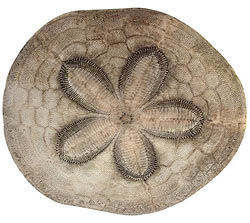The Sand Dollar is a spiny, hard-skinned Echinoderm shaped like a flattened disk. They are green, blue or purple with a velvet-like texture and appearance caused by their spines. They live on the sandy or muddy sea floors, from the intertidal zone to the subtidal zone, usually at depths of 9 to 12 m. They burrow under the sand with an edge poking up out. They are often found in large numbers living together.
They have five sets of pores arranged in a petal pattern. The pores are used to move sea water into its internal water-vascular system which allows them to move. The spines on the underside of the animal allow it to burrow or to slowly creep through the sand. Fine, hair-like cilia cover the tiny spines. These cilia, in combination with a mucous coating, move food to the mouth opening which is in the centre of the star shaped grooves on the underside of the animal. The anus is toward the rear of the animal rather than on the top,
|

|